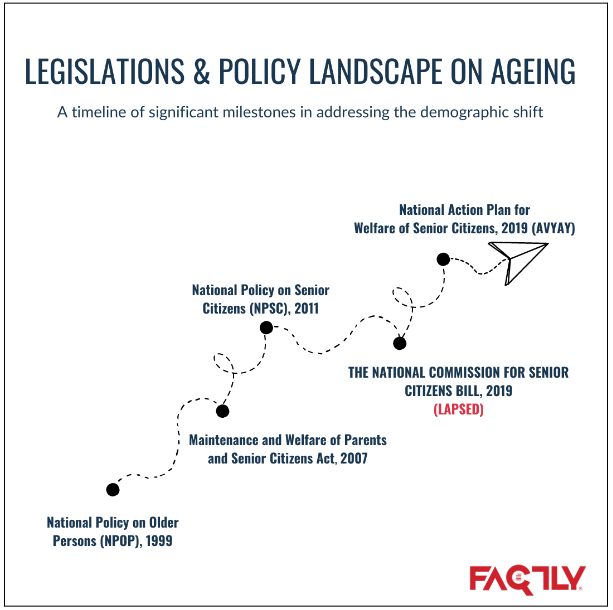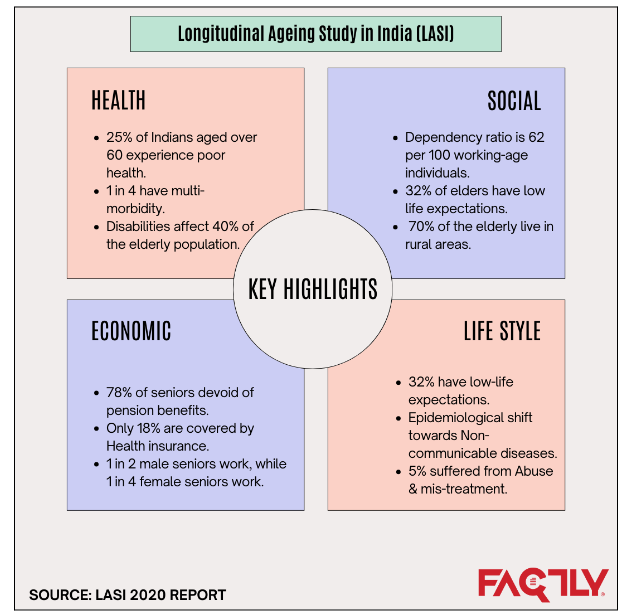The seniors accounted for slightly over 5% of the Indian population in the 1961 Census, while estimates indicate that by 2031, this proportion would be 13% and thus signalling a major shift in demography. NITI Aayog recently released a report looking at this demographic shift and made important recommendations.
The phenomenon of demographic ageing, observed worldwide, has come to India. The number of aged people increased significantly when life expectancy rose. The seniors accounted for slightly over 5% of the Indian population in the 1961 Census, that is about 25 million people approximately. Estimates indicate that by 2031, this proportion would be 13%, and thus signalling a major shift in demography. As regards healthcare, social dynamics and economics among others; this elderly population affects many things.
In its Directive Principles of State Policy, the Constitution of India recognizes the need to protect the rights of all citizens including older persons. Successive governments in India made provisions to address the concerns of senior citizens. Yet, gaps persist in infrastructure and necessary support systems.
In light of the recent release of ‘Senior Care Reforms in India- Reimagining the Senior Care Paradigm’ by NITI Aayog, we look at what the report entails, along with interesting statistics.
Elderly population growing at a faster rate than general population.
Population and its composition are a crucial demographic indicator. In India, the number of elderly individuals has been steadily rising since 1961, with this increase notably speeding up after 1981 mainly due to a decrease in the mortality rate resulting from improved healthcare measures. Several elements contribute to the rise of the elderly population including economic growth, advancements in healthcare and medical services, as well as a decline in fertility rates.
Further, as per the Report of the Technical Group on Population Projections for India and States 2011-2036, the count of elderly individuals in India surged by nearly 32 million between the Population Census of 2011 and 2021. This figure is expected to further increase by approximately 20 million by 2031. In terms of growth rates, while the general population grew by 12.4% from 2011 to 2021, the elderly population expanded by 36% during that same period. This trend of a higher growth rate in the elderly population compared to the general populace was also noted in the two decades between 2001 and 2011.
Framework for senior citizens support in India
In accordance with UN General Assembly Resolution 47/5, which declared 1999 to be the International Year of Older Persons, the Indian government unveiled the National Policy on Older Persons (NPOP) in 1999. The constitutional commitment to older people was also expressed in this project. India’s National Policy on Older Persons was influenced by international initiatives such as the Madrid Plan of Action, the United Nations Principles for Senior Citizens, and other resolutions passed by the UN General Assembly. These international directives, such as the Shanghai Plan of Action and the Proclamation on Ageing, pushed governments—including India’s—to create and implement their own laws.
A major piece of legislation, the Maintenance and Welfare of Parents and Senior Citizens Act was introduced by the Ministry of Social Justice and Empowerment in 2007. A new National Policy of Senior Citizens was subsequently created in 2011, with an emphasis on an age-integrated society. The goals of this policy were to improve both formal and informal social support networks and promote intergenerational integration.
However, several of the policy objectives of the National Senior Citizens Policy have yet to be realised. The proposals include establishing a National Commission for Senior Citizens at the national level, as well as similar commissions at the state level. In 2019, a private member’s bill was also introduced to establish a National Commission for Senior Citizens; however, it was eventually shelved.
Further, establishing an independent, recognised National Association of Older Persons (NAOP) was also advised by the National Policy of Older Persons, 1999, to organise senior persons to promote and articulate their concerns. It was urged that the government assist the association in becoming financially self-sufficient.

How is Indian elderly population doing? Some excerpts from Longitudinal Ageing Survey in India (LASI) 2020.
As India’s population ages, various aspects of society will be impacted. This demographic shift creates complex challenges related to health, social issues, and the economy. Despite current efforts, policy development faces barriers due to a lack of comprehensive data on the ageing process. The Longitudinal Ageing Survey in India (LASI) was initiated in 2016 to address this need by providing robust data and insights into the dynamics and needs of India’s ageing population.

Old-age dependency ratio on the rise, indicating the necessity of improved support for elderly.
The old age dependence ratio indicates the number of people over 60 per 100 people aged 15-59. This ratio among elderly individuals is on the rise. The ratio climbed from 10.9 in 1961 to 14.2 in 2011 and 15.7 in 2021(Projected) and is expected to reach 20.1 in 2031. Female and male dependency ratios are anticipated to increase to 21.5 and 18.8, respectively, by 2031. However, there are considerable disparities in old age dependency ratios between rural and urban areas. In rural areas, the dependency ratio stood at 15.1 in 2011, while for urban areas, it was 12.4. This could partially be due to the higher concentration of working-age population in metropolitan areas.
Among major states, Kerala is expected to have the highest old-age dependency ratio in 2031, with 34.3, followed by Tamil Nadu with 28, and Himachal Pradesh at 26. Bihar and Uttar Pradesh are states with the lowest expected old-age dependency ratios at 15.6 and 15.8 respectively.
Major recommendations of the report
To achieve comprehensive senior care, a fundamental shift is required, focusing on the needs of the elderly population. This transition entails engaging a wide range of partners from both the public and private sectors across the care continuum to provide high-quality support for overall well-being. The government must expand an integrated and comprehensive healthcare environment to increase fitness among senior citizens. This includes enhancing healthcare facilities and the skilled team of workers that provide aged care.
Furthermore, it is recommended to establish a comprehensive social safety and inclusion framework. This can be accomplished by developing a consolidated portal that serves as a ‘one-stop’ platform for easy access to senior-related offerings. Additionally, presenting the care economic system for senior care is critical.


